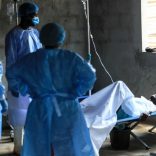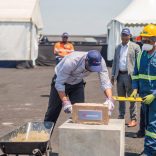Mozambique: Cholera outbreak declared again in Moma district
‘Fill The Nutrient Gap’ – SETSAN and WFP present a study to help reduce malnutrition in Mozambique

Photo (cropped): Twitter @redaellimanente
Mozambique loses more than 10.9% of its annual GDP due to chronic malnutrition, equivalent to a yearly loss of 62 billion MZN (1.6 billion USD), according to a recent study “The Cost of Hunger in Africa” (2017). To help overcome this reality, the Technical Secretariat for Food Security and Nutrition (SETSAN) and the United Nations World Food Programme (WFP) today presented the findings of an analysis that also provides recommendations to help curb malnutrition in Mozambique.
The analysis “Fill The Nutrient Gap” (FNG) tests the effectiveness of interventions aimed to make nutritious diets more available and accessible to the most vulnerable families in Mozambique. The analysis was developed by WFP, UNICEF and IFPRI, stemming from an agreement established in May 2017 between SETSAN, the Scaling up Nutrition (SUN) movement, civil society and the government and private sectors in Mozambique.
“WFP is committed to eliminating malnutrition in Mozambique”, said WFP Mozambique Representative and Country Director Karin Manente. The FNG is not just another study. It compares the cost-effectiveness of various options needed to curb malnutrition and help Mozambique achieve zero hunger, which is possible. We need to continue to strengthen policies and programmes that are multi-sectoral and based on local conditions.”
“The levels of chronic malnutrition are very high in Mozambique. The analysis considers key gaps in nutrition and cost options to address them ”, said SETSAN director of Policies and Planning Claudia Lopes. “We now need to mobilise resources to pursue the most cost-effective actions, prioritising the most vulnerable populations.”
The endorsed report will be disseminated throughout the provinces to promote greater awareness and solutions in reducing chronic malnutrition in the country.
Today @wfp_mozambique is launching our ‘Fill the Nutrient Gap’ report, an analysis of different potential actions to reduce #malnutrition. We hope it will help make nutritious diets more accessible to the most vulnerable in #Mozambique. w/ @UNICEF_Moz https://t.co/sNHU43vIbA pic.twitter.com/QYMrTlnKuf
— Lauren Landis (@LaurenLandis1) April 12, 2018
#HappeningNow presentation of #FillTheNutrientGap #Mozambique on economic variables of chronic malnutrition and costed options to address pic.twitter.com/x59mX1UeLG
— Karin R Manente (@redaellimanente) April 12, 2018
“Mozambique loses more than 10.9% of its annual GDP due to chronic malnutrition”. #Setsan and @wfp_mozambique present a study to help reduce #malnutrition in #Mozambique. https://t.co/lPxTXyVJOC via @reliefweb pic.twitter.com/kmIiFe6Kjs
— UNICEF Moçambique (@UNICEF_Moz) April 12, 2018
#FillTheNutrientGap workshop: results validation for each Province of Mozambique. Thanks to @SETSAN, @wfp_mozambique , @Irish_Aid , @USAIDMozambique , @UNICEF_Moz pic.twitter.com/KxzfGNJruA
— filippo dibari (@filippodibari) April 12, 2018












Leave a Reply
Be the First to Comment!
You must be logged in to post a comment.
You must be logged in to post a comment.